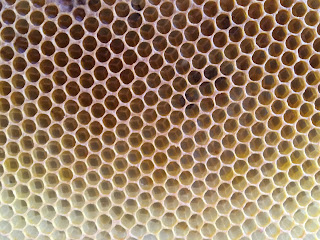Bee Check
We had an incredibly warm day last week — 75 degrees in February! — which was perfect for checking in on the bees. You can’t open the hive when it’s colder than about 55 degree for risk of chilling them, but they were all out and about enjoying the weather anyway, so we dove in.
As suspected, the hive of bees that swarmed is still going strong, but the ones left behind in the original hive didn’t make it. I moved the mouse guard away from the door of the good hive to allow the bees access to all three entrances, and this gave them more room to start bringing out the dead.
One of the more disconcerting things about a wine hive is that the bees can’t break free of their tight cluster when it’s cold, or they’ll freeze to death. That means that chores like carrying dead bees out of the hive have to wait until spring.
There are a lot of dead bees in there.
Still, as soon as I moved the door, they started carrying out little bee corpses. I also put out some extra sugar water for them, which they seemed to enjoy.
That was on the first of a pair of warm days. On the second day, Kirk and I opened the hive to inspect honey stores. They still had two to two and a half combs with honey (some capped, some uncapped), which is a good sign. I used a kid’s sand shovel to help remove piles of dead bees, and we even saw the queen.
And I have no idea where they were getting pollen, but we saw some foragers come back with full little leg pouches of light yellow pollen. Witch hazel, maybe?
This is a strong hive!
The bees still have a good month of winter to get through before they might be able to forage for new food in earnest, and a lot could happen in that time. We pulled a couple combs of capped honey from our dead hive to add to their stores to help them out. We’ll also check on their food supply again on our next warm day in March. If it looks like they’re running out of honey, we’ll have to supplement with fondant or syrup until they can find their own nectar again.
As suspected, the hive of bees that swarmed is still going strong, but the ones left behind in the original hive didn’t make it. I moved the mouse guard away from the door of the good hive to allow the bees access to all three entrances, and this gave them more room to start bringing out the dead.
One of the more disconcerting things about a wine hive is that the bees can’t break free of their tight cluster when it’s cold, or they’ll freeze to death. That means that chores like carrying dead bees out of the hive have to wait until spring.
There are a lot of dead bees in there.
Still, as soon as I moved the door, they started carrying out little bee corpses. I also put out some extra sugar water for them, which they seemed to enjoy.
That was on the first of a pair of warm days. On the second day, Kirk and I opened the hive to inspect honey stores. They still had two to two and a half combs with honey (some capped, some uncapped), which is a good sign. I used a kid’s sand shovel to help remove piles of dead bees, and we even saw the queen.
And I have no idea where they were getting pollen, but we saw some foragers come back with full little leg pouches of light yellow pollen. Witch hazel, maybe?
This is a strong hive!
The bees still have a good month of winter to get through before they might be able to forage for new food in earnest, and a lot could happen in that time. We pulled a couple combs of capped honey from our dead hive to add to their stores to help them out. We’ll also check on their food supply again on our next warm day in March. If it looks like they’re running out of honey, we’ll have to supplement with fondant or syrup until they can find their own nectar again.
By nightfall on the second warm day, temperatures were dropping and I had to put the mouse guard back on the hive to keep it snug for winter (which is still is after all). We also have an inadvertent souvenir of the day, as the comb on the very first bar broke off in our hands. It’s completely empty of honey and brood, though, so it doesn’t seem to be much of a loss. I’ll hang onto it to melt down for out next wax harvest.




Comments
Post a Comment